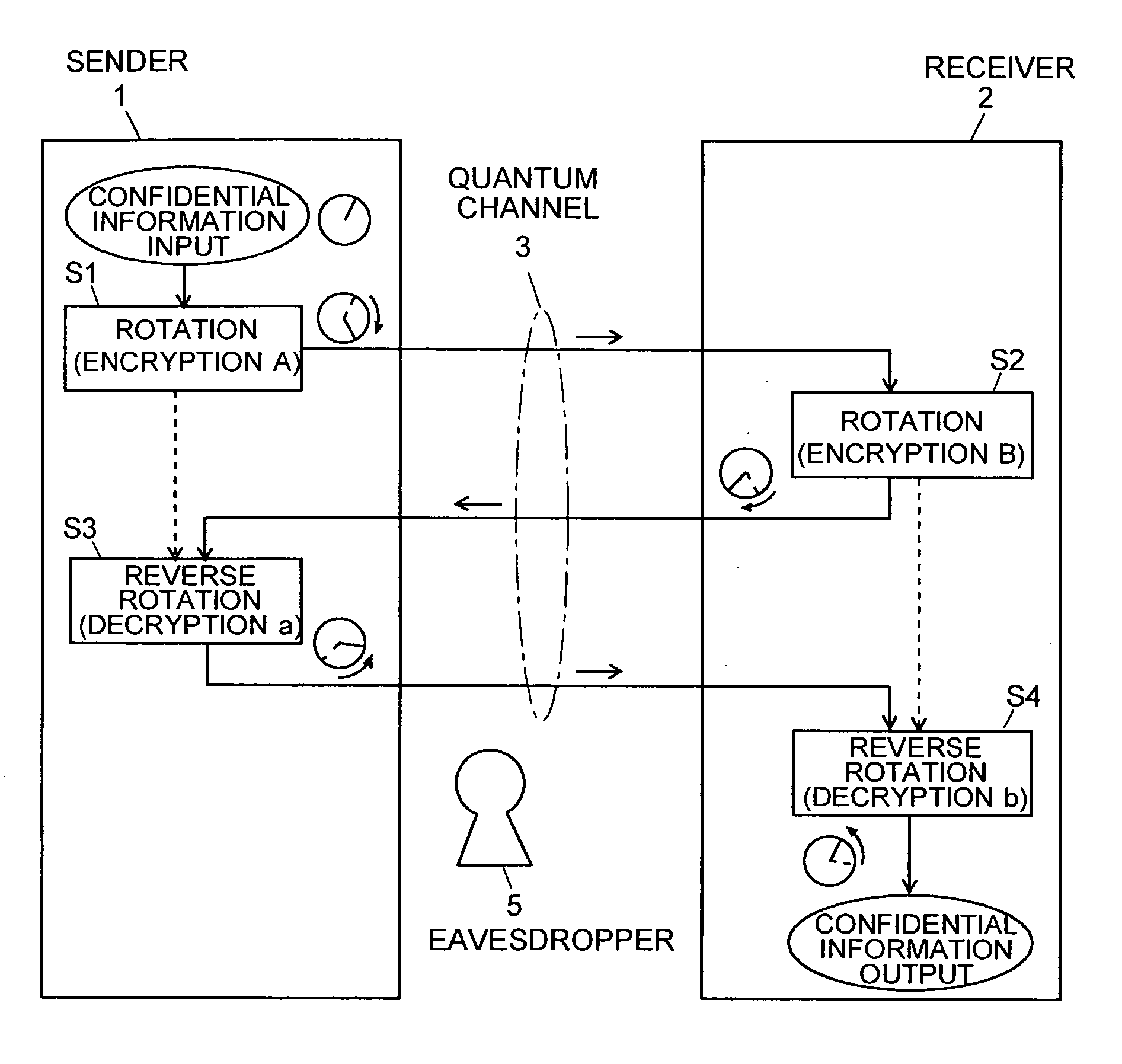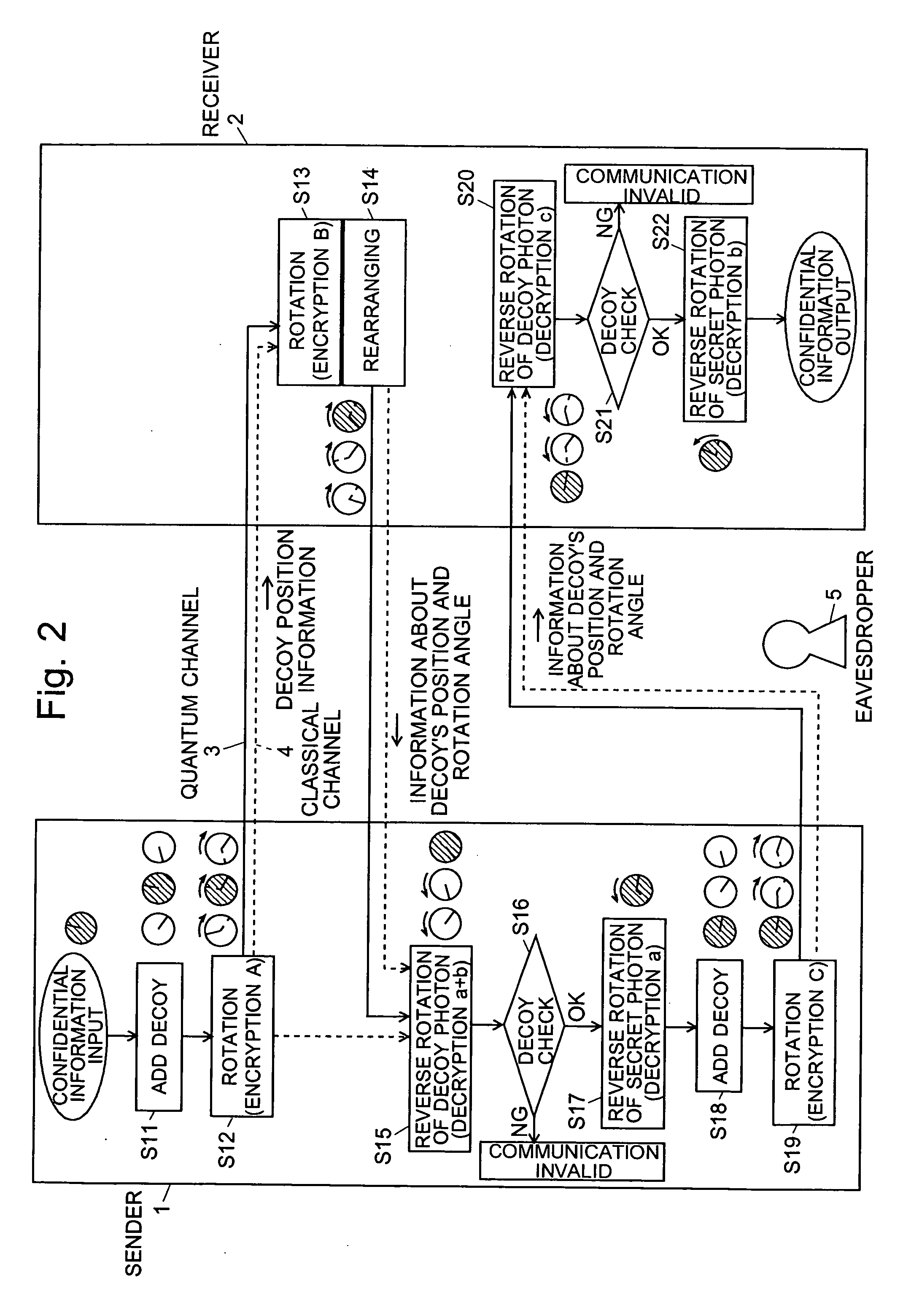Quantum Cryptographic Communication Method
a cryptographic communication and quantum technology, applied in the field of quantum cryptographic communication methods, can solve the problems of leaking information, protocol cracking, and possible threat to the computation security of the current method, and achieve the effect of facilitating restrictions concerning hardware configuration and high security levels
- Summary
- Abstract
- Description
- Claims
- Application Information
AI Technical Summary
Benefits of technology
Problems solved by technology
Method used
Image
Examples
first embodiment
[0065]As an embodiment of the present invention, a quantum cryptographic communication protocol that forms the basis of the invention is described using FIG. 1, which is a conceptual diagram illustrating the quantum cryptographic communication protocol according to the first embodiment.
[0066]The sender 1 and receiver 2 are connected with each other through a quantum channel 3 capable of bi-directional communications. The purpose of communication in this example is to send confidential information from the sender 1 to the receiver 2 through the quantum channel 3. The quantum channel 3 bi-directionally transmits quantum-theoretical particles. The present embodiment assumes that photons are transmitted one by one so that each photon serves as one qubit. In this case, an optical fiber or similar optical transmission channel can be used as the quantum channel 3. The confidential information is represented by the polarization angle of a single photon. The communication procedure will be a...
second embodiment
[0080]FIG. 2 is a conceptual diagram illustrating a quantum cryptographic communication protocol according to the second embodiment. The present embodiment shares the same basic concepts with the first embodiment in that the encryption and decryption of a photon are achieved by rotational and reverse-rotational manipulations, and in that no information corresponding to the secret keys used for encryption is transmitted through the channels. In addition, the protocol according to the second embodiment employs a decoy with the intention of confusing the eavesdropper 5. Sharing information about the decoy through a classical channel between the sender 1 and the receiver 2 enables them to detect the presence of an eavesdropper 5. The following description illustrates the communication procedure of this quantum cryptographic communication protocol, using FIG. 2.
[0081][Step S11]
[0082]In the present example, two decoys (which are hereinafter called the decoy photons) each having a known in...
third embodiment
[0107]In the third embodiment, those steps which are identical or corresponding to those of the protocol in the second embodiment are denoted by the same step numbers. That is, the operations and processes in Steps S11 through S16 are the same as in the second embodiment. Therefore, these steps will not be explained in the following description.
[0108][Steps S30 and S31]
[0109]If, in Step S16, the quantum state of the two decoy photons is identical to their initial quantum state, then whether or not the next transmission is the last one is determined, and if not the last one, the process goes to Step S31. In Step S31, a total of three photons, i.e. two decoy photons and one secret photon, are each encrypted by a rotational manipulation, as in Step S12. The quantities of this manipulation may or may not be equal to those of the encryption A. For the sake of distinction from the encryption A, the present encryption will be labeled A′.
[0110][Step S32]
[0111]Subsequently, the three photons...
PUM
 Login to View More
Login to View More Abstract
Description
Claims
Application Information
 Login to View More
Login to View More - R&D
- Intellectual Property
- Life Sciences
- Materials
- Tech Scout
- Unparalleled Data Quality
- Higher Quality Content
- 60% Fewer Hallucinations
Browse by: Latest US Patents, China's latest patents, Technical Efficacy Thesaurus, Application Domain, Technology Topic, Popular Technical Reports.
© 2025 PatSnap. All rights reserved.Legal|Privacy policy|Modern Slavery Act Transparency Statement|Sitemap|About US| Contact US: help@patsnap.com



